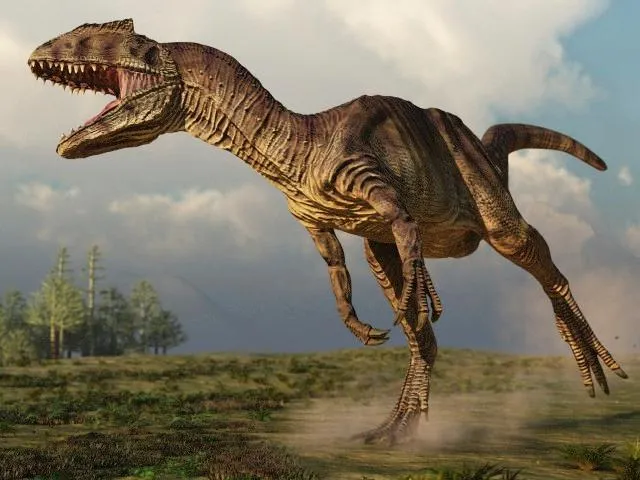Stop Making Fun of Tyrannosaurs’ Tiny Arms
The stubby limbs may seem out of place, but they may have been key to the T. rex’s terrifying bite
/https://tf-cmsv2-smithsonianmag-media.s3.amazonaws.com/filer/9a/56/9a56dd4d-63b4-46b4-ac58-bbbf349afa33/corbis-42-22599625.jpg)
We often ridicule what we love, and, in the realm of dinosaurs, that may explain our complicated relationship with the late, great Tyrannosaurus rex. The gigantic carnivore is the A-list celebrity of the Mesozoic, making repeated appearances on the silver screen as well as holding an obligatory presence in most museum exhibits. Yet, we just can’t stop ourselves from poking fun at the tyrant’s dinky arms. Maybe, though, it’s time we stifle our laughter.
You’d expect that any saurian that lived up to the title of apex predator would have had burly arms tipped in wicked, curved claws. But instead, the king of the lizards bears nothing more than a pair of two fingered stubs. The ferocity of the dinosaur is always undercut by the silliness of its twiddly little forelimbs.
T. rex isn’t even the most extreme of the stubby-armed carnivorous dinosaurs. The Jurassic Ceratosaurus also had comparatively tiny arms with little, stubby-clawed fingers that would have been little help at all in catching or killing anything, as paleontologists Matthew Carrano of the Smithsonian National Museum of Natural History and Jonah Choiniere of the University of Witwatersrand pointed out in a recent paper in the Journal of Vertebrate Paleontology. This sharp-toothed dinosaur must have been all mouth when hunting.
Its later relative Carnotaurus took the trend even further. While the entire dinosaur measured about 30 feet long, its arms were no longer then yours, the fingers and bones of the lower arm mashed together into a useless mitt that confirm Carnotaurus was not much for upper-body workouts.
But we may have been looking at these dinosaurs all wrong.
To the eyes of University of Southern California paleontologist Michael Habib, it’s the predatory dinosaurs with longer arms and giant claws, such as the Jurassic-era Allosaurus, that don’t make sense.
Everyone jabs at T. rex, but “Allosaurus arms were awfully out of the way, too,” Habib says. The Jurassic carnivore’s relatively longer arms and larger claws look more impressive, yet their superiority has always been assumed rather than demonstrated. In Habib’s view, this has given us a skewed view of how these dinosaurs hunted.

“There is actually no way to get the hands of Allosaurus anywhere near its mouth,” Habib says, meaning that these dinosaurs would have to attack impossibly large prey in order to use both teeth and claws in tandem. More than that, Allosaurus and similarly equipped dinosaurs probably couldn’t even see their arms while on the hunt. For these carnivores to use their arms at all, Habib says, they “would have to miss with the mouth, keep charging forward, hit the prey animal hard with its chest and then try to grab it blindly” with arms that were not especially flexible or dexterous. Bigger might not be better after all.
While the smaller arms of dinosaurs like Tyrannosaurus and Ceratosaurus might be good for a laugh, Habib notes that there are biomechanical reasons why smaller limbs may have the advantage. “The bones of the chest and shoulder, such as the coracoids and scapula, are anchor points for muscles going into the arm,” Habib says, “but they are also anchor points for neck muscles.” Only so much muscle can attach to any given bone. But by reducing the size of the arms and the muscles needed to move them, evolution may have allowed dinosaurs like Tyrannosaurus to allot more space to the neck muscles that gave them devastating bites.
“Keeping the bones around the chest and shoulder large, while reducing the forelimbs, provided more room for big neck muscles, which actually makes a lot of sense for predators that relied on large heads as their primary weapons,” Habib says. Think less lion, and more hyena or wild dog.
If shorter arms were better for big, knife-toothed dinosaurs, though, this raises the question of why Allosaurus and similar dinosaurs weren’t shaped like Tyrannosaurus. One possibility, Habib says, is that dinosaurs like Allosaurus hunted and fed in such a way that they did not require super-powerful bites. “They could have been jaw slashers or grabbers that focused on small to medium prey,” Habib says, and so there just wasn’t pressure to evolve more powerful neck muscles. It’s also possible that dinosaurs with longer torsos could use their arms for a bit of a push while getting up from a nap, but there’s no definitive answer just yet.
Much remains unknown about the way our favorite snaggletoothed dinosaurs went about hunting and killing prey. The discrepancy Habib sees is a brain-teaser that awaits detailed study, even as comparative anatomy hints that carnivorous dinosaurs behaved differently than we immediately expect. That’s the difficulty of being over 66 million years too late to watch them in action.
But for now, Habib says, we should give Tyrannosaurus a break. “The key bit isn’t that it had small arms, but that it had an enormous head! …That giant set of bone-crushing, muscle-rending jaws was made possible, in part, by having small arms.” And this, Habib says, “made T. rex a tougher animal, not a weaker one.”
/https://tf-cmsv2-smithsonianmag-media.s3.amazonaws.com/accounts/headshot/RileyBlack.png)
/https://tf-cmsv2-smithsonianmag-media.s3.amazonaws.com/accounts/headshot/RileyBlack.png)